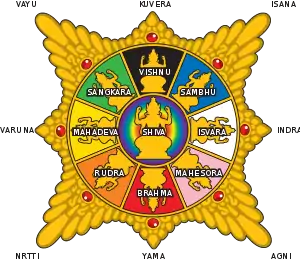Surya Majapahit
Surya Majapahit (The Sun of Majapahit) is the emblem commonly found in ruins dated from the Majapahit era. The emblem commonly took the form of an eight-pointed sun ray with the rounded part in the center depicting Hindu deities. The emblem might have taken the form of a cosmological diagram haloed by typical "Surya Majapahit" sun rays,[1] or a simple circle with typical sun rays. Because of the popularity of this sun emblem during the Majapahit era, it is suggested that the sun emblem served as the imperial symbol or emblem of the Majapahit empire.

Hindu deities
The most common depiction of Surya Majapahit consists of the images of nine deities and eight sun rays. The round center of the sun depicting nine Hindu gods called Dewata Nawa Sanga. The major gods in the center is arranged in eight cardinal points around one god in the center. The arrangements are:
- Center: Shiva
- East: Isvara
- West: Mahadeva
- North: Vishnu
- South: Brahma
- Northeast: Sambhu
- Northwest: Sangkara
- Southeast: Mahesora
- Southwest: Rudra
The minor deities located at the outer rim of the sun, symbolized by eight shining sun rays:
- East: Indra
- West: Varuna
- North: Kubera
- South: Yama
- Northeast: Isana
- Northwest: Vayu
- Southeast: Agni
- Southwest: Nirṛti


The emblem is rendered in many forms; sometimes it took the form of the circle of deities and sun rays, or just a simple eight-pointed sun ray such as the emblematic Surya Majapahit set into the ceiling of Candi Penataran.[2] The deities in the sun arranged as cosmological diagram in the form of a mandala. Another variation of Surya Majapahit is the eight pointed sun rays with the god of sun Surya in the center riding celestial horse or chariot. The carving of Surya Majapahit usually can be found on the center ceiling of the Garbhagriha (inner sanctum) of the temple such as Bangkal, Sawentar, and Jawi temple. Surya Majapahit also can be found on the Stella, carving of halo or aura at the back of the statue's head. The carving of Surya Majapahit also commonly found in gravestone dating from Majapahit era, such as the Troloyo cemetery in Trowulan.
See also
- Star of Lakshmi - a star-shaped symbol that represents Lakshmi, the Hindu goddess of wealth
References
General
- Exhibit of "Kejayaan Kerajaan-kerajaan Kuno Indonesia" (The Glory of Ancient Indonesian Kingdoms) at Istana Anak-anak Indonesia, Taman Mini Indonesia Indah, displayed Majapahit artifacts the collection of Trowulan Museum, East Java. April 2009.
- Bullough Nigel (1995). Historic East Java, Remains in Stone, 50th Anniversary of Indonesia Commemorative Edition. Jakarta: ADLine Communications. p. 109.
- Bullough Nigel (1995). Historic East Java, Remains in Stone, 50th Anniversary of Indonesia Commemorative Edition. Jakarta: ADLine Communications. p. 91.